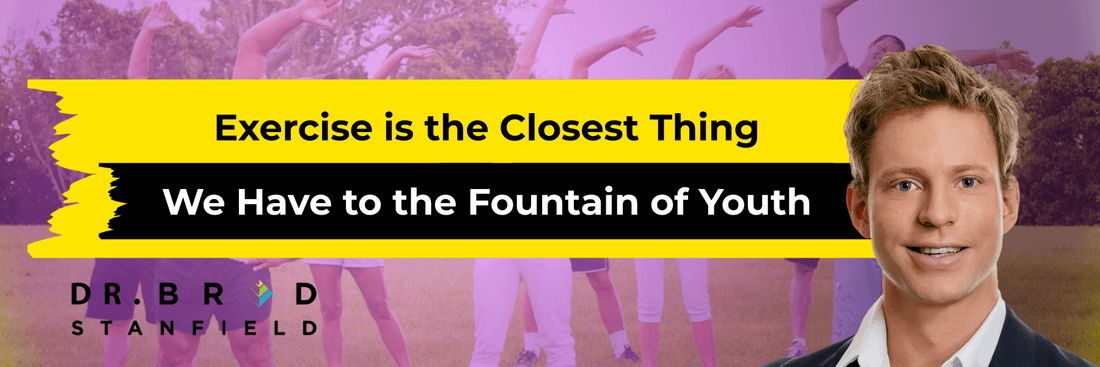A world-renowned researcher, Dr. Brad Schoenfeld, recently highlighted a study he described as “the closest thing we have to the fountain of youth” [1].

This article explores that study and Dr. Schoenfeld’s commentary, because most people drastically underestimate just how significant a difference exercise makes. The numbers in the new study might surprise you—they certainly surprised me. They relate to how adults in their late 60s who exercise compare to those in their 20s who don’t.
Table of Contents
What We Already Know – The Benefits of Exercise
We already know that exercise can lower the risk of premature death by 19 to 25% [2].

But what does the impact of exercise on aging actually look like in real life? One of the most valuable things for quality of life as we age is the ability to stay physically active. And we all know that physical function tends to decline with age.
A fascinating study compared older master athletes to different groups, including moderately active young people. These master athletes had been strength training for years. Their average age was about 70. Yet, in the leg press, they had a 26% higher maximal strength than the young group [3].
On the one hand, these data are amazing. They reveal 70-year-olds can outperform moderately active people in their 20s on certain measures of fitness.
On the other hand, these were elite individuals who train intensively and compete in athletic events. So while interesting, it may not seem relevant to most people.
The New Study
A more relevant question is: what are the impacts on physical mobility for the average person who exercises regularly but isn’t winning marathons in retirement?

That’s exactly what the new study Dr. Schoenfeld referenced is about [4].
It looked specifically at resistance training. Researchers identified four groups of healthy adults—two younger (with and without resistance training), and two older (with and without resistance training) [4].
They performed a variety of tests that highlight the typical declines associated with aging [4].
The results can be grouped into three categories: physical function, muscle strength, and muscle mass.
Physical Function
The findings here were remarkable. Take the 30-second sit-to-stand test, where participants had to stand up and sit down from a chair as many times as possible in 30 seconds. The older resistance-trained group performed just as well as the young resistance-trained group—and even outperformed the young group that didn’t do resistance training [4].

Similar results were seen across many other tests. The older group maintained physical function at least at the level of the young, non-resistance-trained participants.
For context, the “young” participants were in their mid-20s. The “old”? Nearly 70 on average [4].

Let that sink in for a moment. With regular resistance training, a 70-year-old can maintain the ability to do things like climb stairs and rise from a chair at a level similar to someone in their 20s. On some measures, they were even similar to younger adults who resistance train regularly. And while tasks like climbing stairs or getting up from a chair might sound trivial, they’re key to maintaining quality of life in old age [4].
Muscle Strength
When it came to strength, tests measured things like handgrip and knee extension. Here, the young resistance-trained group scored highest, as expected. The other three groups—older trained, older untrained, and young untrained—were fairly similar [4].

It’s worth noting that even the older untrained group maintained comparable strength to the young untrained group. Researchers suggest this could be due to daily physical activities that helped preserve their strength [4].
Muscle Mass
One expected finding was that the young resistance-trained group had slightly more muscle mass than the older resistance-trained group. But here’s what surprised me: the older resistance-trained group only had a small edge in muscle mass over the older untrained group [4].

Despite that, the older resistance-trained individuals scored much better in functional tests. That suggests performance isn’t just about bigger muscles—it’s also about more efficient brain and nerve signaling. And the researchers believe this “neuromuscular adaptation” could be even more important for maintaining function [4].
This insight might also support the idea of building muscle mass when we’re younger. Muscle typically peaks around age 30 to 35, then declines slowly, and more rapidly after age 65 or 70 [5].
The higher that peak in our 30s, the more muscle we’ll retain into our 70s. That’s part of the reason I personally supplement with MicroVitamin+ Powder—it contains creatine monohydrate and TMG to support my workouts and recovery. But just because I take a supplement doesn’t mean you need to.
Regardless, the study’s takeaway is clear: older adults who resistance train maintain physical function into their 60s at levels similar to 20-year-olds who don’t resistance train—and in some cases, even those who do [4].
And we’re not talking about elite athletes. These were everyday people who met basic resistance training guidelines: strength training for all major muscle groups at least twice a week [4].
These findings are hugely significant. About 45% of older adults are affected by muscle loss and reduced physical function. This often leads to loss of independence and lower quality of life [4].
But this study shows we can use resistance training to help prevent that.
Resistance vs. Aerobic
This study focused on resistance training. So what about cardio and other forms of exercise?
All exercise is beneficial. But different types make unique contributions to health.

If your goal is strength and muscle mass, resistance training is key. Endurance exercises like jogging, on the other hand, are best at boosting VO2max and cardiorespiratory fitness [6].
There’s another often-overlooked type of fitness—muscle power. Unlike strength (how much force you can produce), power is about how quickly you can produce that force. It declines faster than strength as we age—and appears to be even more important in maintaining function [7].
Think about daily activities like rising from a chair. The speed of movement is often more limiting than strength alone.
One large study of nearly 4,000 people found muscle power was a stronger predictor of mortality than strength [8].
And studies have shown that power training is more effective than strength training alone in preserving this capacity [7].
Power training combines speed and resistance. In one study, older adults were instructed to perform exercises as quickly as possible while wearing weighted vests [9].
So ideally, our exercise routines should include resistance, endurance, and power training. The specific benefits of each complement one another.
How much exercise do we need? A common guideline is at least 150 minutes of moderate-intensity aerobic activity per week, or 75 minutes of vigorous activity. You can also do a mix of both [10].
Reference List
1. https://x.com/BradSchoenfeld/status/1933949516312367598
2. https://www.ahajournals.org/doi/full/10.1161/CIRCULATIONAHA.121.058162
5. https://www.nia.nih.gov/news/how-can-strength-training-build-healthier-bodies-we-age
6. https://pmc.ncbi.nlm.nih.gov/articles/PMC5983157/
7. https://pmc.ncbi.nlm.nih.gov/articles/PMC9367108/
8. https://www.mayoclinicproceedings.org/article/S0025-6196(25)00100-4/fulltext
9. https://pmc.ncbi.nlm.nih.gov/articles/PMC2720885/
10. https://www.mayoclinic.org/healthy-lifestyle/fitness/expert-answers/exercise/faq-20057916























































